This farkle I invented already back in 2005. As most of LT riders know, you can ride the bike handsfree (without holding the handlebars) but you need to shift your weight slightly from side to side. And many have also tried this "handsfree mode" in too low speeds (i.e 60-70 km/h) WHICH YOU SHOULD NOT TRY. The famous wobble effect is at it's worst on those speeds.
I'm talking about speeds over 80 km/h, that is when you can ride an LT without holding the handlebars, which of course you can only do when the traffic allows this. And if you reach even your little finger to touch the handlebar you don't need to balance and "steer" the bike any more with your body balancing.
Anyway, I have an upper back problem and holding the handlebars with my both hands for a longer period of time gives me really nasty pain between my shoulder blades. This is always at its worst in the beginning of the riding season, even less than 100 km is too much.
So in order to relieve the upper back pain I started planning a system where I can sit more relaxed with my arms in my lap and still have a control on the bike's steering.
I developed the Highway Handle.
 |
| This was taken somewhere in Tennessee back in 2006 when we rode through 3 Canadian provinces and 19 US states in 2 weeks and the Highway Handle was really useful. |
 |
| The handle is actually made from a telescopic Nordic Walking poles which are typically made of aluminium and you can adjust their length by pulling / pushing and then lock it by rotating the other part. The Nordic walking sticks (or Hiking poles) can be found in most sport shops. |
 |
| This is the part that is bolted in the extra holes that can be found in the LT handlebars. I have installed the K 1200 RS handlebar mirrors (which BTW are 100% better than the LT original mirros) and this piece bolts right on to the mirror's 8 mm threaded bolt. All the joints are tight enough so that Handle always stays in the position you leave it. It should not hang loose at any time. |
 |
| Here the handle is folded away. |
 |
| Here it is in "short mode". |
 |
| Here it is in fully extended mode. |
Now, some people might consider this dangerous if not insane system. I remember one rider commenting this some 14 years ago by telling how he has been scuba diving, parachute jumping and water skiing but he would never ever dare to ride his bike with this kind of handle...
Oh well, each to his own. I have ridden with this about 200.000 km, I never use it in dense traffic. For instance on my numerous German trips I have very little use for this. On the contrary, on my several trips through the 49 states of US on Gold Wings or Harleys I always take my Highway Handle along and install it on the rental bikes. However on my last trip the shaking of H-D was too much for my Handle and I lost the adjustable part of it somewhere between Jacob Lake AZ and Kanab UT.
When you have open road in front of you, this is a one of my favorite farkles!



































































